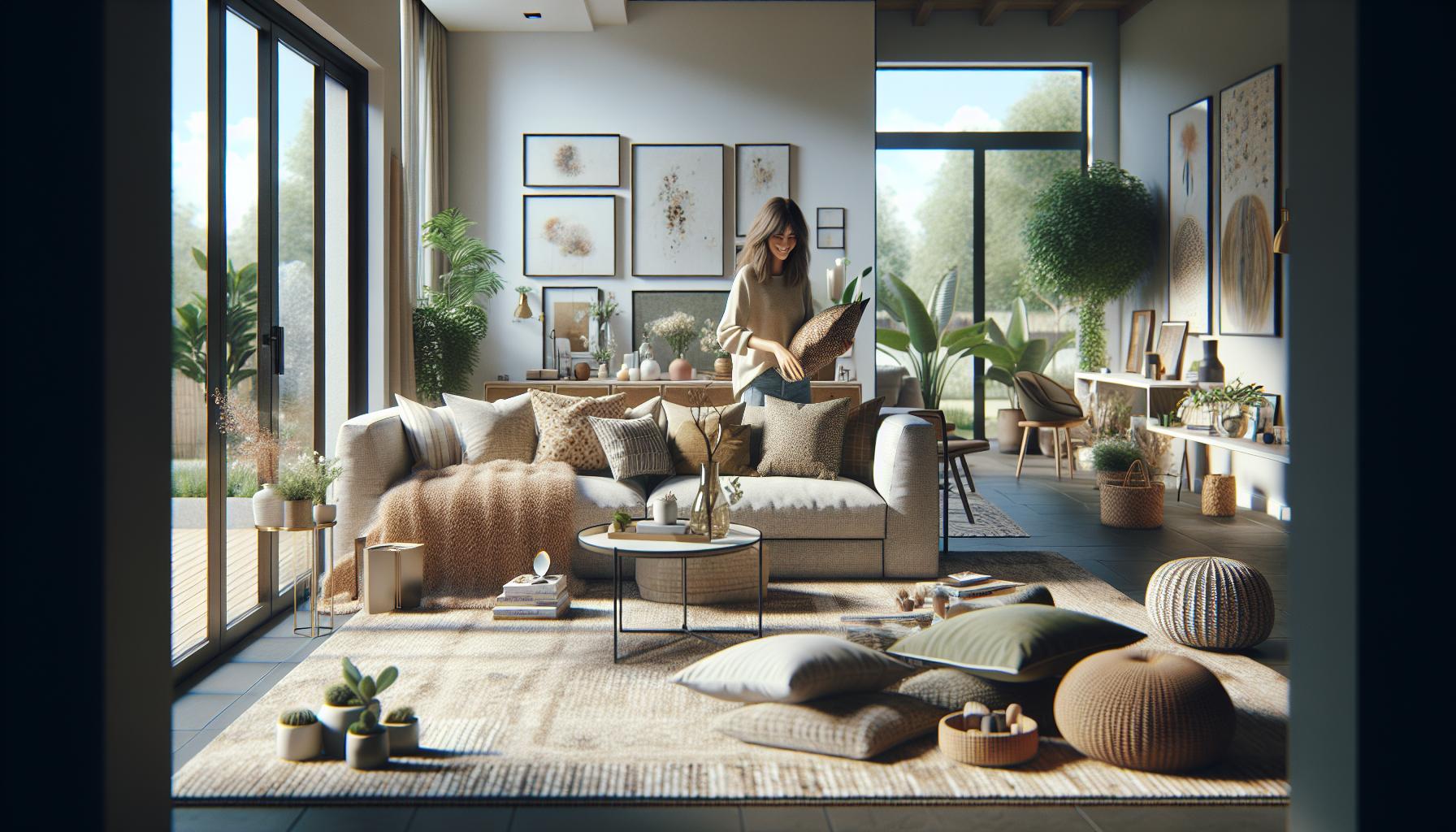”
Key Takeaways
- Bold Color Palettes: 2024 showcases vibrant colors like deep blues, rich greens, and vibrant reds, offering a striking visual contrast that enhances curb appeal.
- Sustainable Materials: Eco-friendly options are on the rise, including reclaimed wood and energy-efficient windows, promoting a responsible aesthetic while reducing environmental impact.
- Unique Architectural Features: Asymmetrical designs, oversized doors, and creative roofing styles are popular, adding personality to facades and inviting curiosity.
- Emphasis on Outdoor Living: Patios, decks, and outdoor kitchens are becoming essential, creating seamless extensions of indoor spaces for relaxation and entertainment.
- Integration with Nature: Home designs focus on harmony with natural surroundings, incorporating elements like lush landscaping and water features to nurture tranquility.
- Smart Home Trends: Technology integration enhances functionality with features like intelligent lighting and automated irrigation, promoting convenience and energy efficiency in outdoor spaces.
As 2024 approaches, homeowners are eager to refresh their outdoor spaces with the latest design trends. The exterior of a home sets the tone for its overall aesthetic and creates a welcoming atmosphere. This year, innovative styles and sustainable materials take center stage, reflecting a growing desire for both beauty and functionality.
From bold color palettes to eco-friendly landscaping, the trends promise to transform ordinary facades into stunning showcases. Homeowners are embracing unique architectural elements and outdoor living spaces that blend seamlessly with nature. Discovering these trends not only enhances curb appeal but also increases property value, making it a smart investment for the future.
Exterior Home Design Trends 2024
Exterior home design trends for 2024 focus on creating inviting outdoor spaces that reflect personal style and enhance property value. Homeowners increasingly prefer features that emphasize sustainability and uniqueness in design.
Bold Colors
Bold colors, such as deep blues, rich greens, and vibrant reds, dominate exterior palettes. These hues offer a striking contrast against natural settings, making homes stand out. Homeowners select these shades to create a dynamic visual appeal.
Sustainable Materials
Sustainable materials gain traction, emphasizing eco-friendliness. Options like reclaimed wood, recycled metal, and energy-efficient windows not only reduce environmental impact but also enhance the aesthetic appeal of exteriors. These materials contribute to a well-rounded and responsible home design.
Unique Architectural Elements
Unique architectural elements, including asymmetrical designs, oversized doors, and creative roofing styles, rise in popularity. These elements inject personality into home facades and invite curiosity, offering a fresh take on traditional designs.
Outdoor Living Spaces
Outdoor living spaces, such as patios, decks, and outdoor kitchens, become essential extensions of homes. These areas facilitate outdoor entertaining and relaxation, with trends leaning towards furniture that blends comfort and durability. Incorporating greenery, such as vertical gardens or trellises, enhances the connection to nature.
Integration with Nature
Integration with nature remains a key theme, featuring designs that harmonize with surrounding landscapes. Homeowners choose natural stones, lush landscaping, and water features to create a seamless flow between the indoors and outdoors. This approach nurtures a tranquil environment and enhances the overall experience.
These trends in exterior home design for 2024 represent a shift towards more personalized, eco-conscious, and visually appealing outdoor spaces.
Color Palettes for 2024
Color choices play a vital role in enhancing a home’s exterior appeal. In 2024, homeowners can expect a blend of bold and neutral shades that create striking visual effects while maintaining a harmonious relationship with nature.
Trendy Color Combinations
Trendy color combinations for 2024 emphasize high contrast and vibrant energy. Popular pairings include:
- Deep Blue and Soft White: Deep blues create an elegant backdrop, while soft whites add brightness and clarity.
- Rich Green and Warm Beige: Rich greens bring a sense of tranquility, complemented by warm beiges that add warmth and approachability.
- Vibrant Red and Charcoal Gray: Vibrant reds provide a strong focal point, balanced by the sophistication of charcoal gray.
- Terracotta and Olive Green: Terracotta tones evoke warmth and earthiness, with olive greens enhancing the organic feel.
These combinations reflect a desire for individuality and creativity in home design.
Popular Neutrals
Popular neutrals for 2024 focus on versatility and understated elegance. Common choices include:
- Soft Gray: Soft grays offer a subtle backdrop, making architectural elements stand out effectively.
- Warm Taupe: Warm taupe adds a touch of sophistication, while remaining inviting and adaptable to various styles.
- Creamy White: Creamy whites provide a timeless, classic look, allowing for various accent colors and materials to shine.
- Sage Green: Sage green adds a hint of color while maintaining neutrality, blending seamlessly with natural surroundings.
These neutral tones continue to be favored for their timeless appeal and ability to combine effortlessly with bolder accents.
Materials and Textures
In 2024, outdoor design emphasizes the use of natural materials and innovative textures to enhance aesthetic appeal and sustainability. Each choice contributes to creating inviting and unique home exteriors.
Natural Materials
Natural materials gain popularity in exterior design, enriching the visual landscape with organic beauty. Reclaimed wood, for instance, provides character and warmth, while promoting eco-friendliness. Natural stone, like slate and granite, offers durability and versatility, fitting various architectural styles. Terracotta tiles add rustic charm and complement lush greenery. Homeowners often select bamboo for fencing and decking due to its rapid renewability and stylish appearance. These materials connect homes with nature, creating an inviting ambience.
Innovative Textures
Innovative textures transform home exteriors, providing depth and intrigue. Textured stucco surfaces create striking contrasts against smooth accents, enhancing visual interest. Steel siding with unique patterns offers modern elegance while ensuring low maintenance. Wood accents, such as shiplap or board and batten, contribute warmth and rustic appeal. Porcelain pavers, now available in various finishes, imitate the look of natural stone without the weight or upkeep. Combining different textures fosters individuality and enhances the overall design, making exteriors more dynamic and appealing.
Architectural Styles
Architectural styles for 2024 focus on both modern minimalism and rustic charm, each offering distinct aesthetic advantages. These styles combine functionality with creativity, appealing to a wide range of homeowners.
Modern Minimalism
Modern minimalism emphasizes clean lines, functional design, and a lack of clutter. This style integrates neutral color palettes with bold accents, using materials like glass, steel, and concrete. Flat roofs, large windows, and open spaces characterize this trend. Textured elements, such as wooden slats and potted greenery, add warmth without compromising simplicity.
Rustic Charm
Rustic charm evokes a sense of warmth and coziness through natural materials and traditional design elements. Homeowners increasingly opt for stone, reclaimed wood, and brick, establishing a connection to nature. Exposed beams, gabled roofs, and wide porches enhance the inviting appeal. Earthy color palettes, which include deep browns, muted greens, and warm grays, complement the rustic aesthetic.
These architectural styles not only reflect personal preferences but also enhance exterior appeal, promoting outdoor living and sustainable practices.
Landscape and Outdoor Spaces
The 2024 exterior design trends showcase an increasing focus on enhancing landscapes and outdoor areas. Sustainable practices and functional aesthetics are key components shaping these environments.
Sustainable Landscaping
Sustainable landscaping emphasizes the use of native plants, drought-resistant species, and eco-friendly practices. Native plants minimize water usage and support local ecosystems. Incorporating xeriscaping techniques, such as rock gardens and gravel paths, also reduces the need for irrigation. Additionally, homeowners increasingly opt for rain gardens that manage stormwater while promoting biodiversity. Organic mulch and compost enrich soil health naturally, fostering a thriving garden ecosystem. These practices not only lower maintenance costs but also contribute to a healthier planet.
Outdoor Living Spaces
Outdoor living spaces continue to gain prominence in 2024, with a focus on comfort and functionality. Patios and decks serve as extensions of indoor areas, featuring comfortable seating and durable furnishings. Outdoor kitchens are becoming standard, equipped with grills, refrigerators, and countertops, making them ideal for entertaining. Pergolas and canopies provide shade and define spaces while enhancing aesthetic appeal. Fire pits and outdoor fireplaces add warmth and atmosphere, encouraging year-round use. Integrating lighting into these spaces, such as string lights or built-in LEDs, creates an inviting ambiance during evening gatherings. These elements foster a seamless blend between the indoors and outdoors, enhancing overall living experiences.
Smart Home Integration
Smart home integration transforms exterior home design for 2024, focusing on convenience and enhanced functionality. Homeowners increasingly seek technology that seamlessly blends with their outdoor spaces.
Technology in Exterior Design
Technology in exterior design enhances both security and enjoyment. Intelligent lighting systems allow homeowners to control outdoor illumination via mobile apps, creating customizable atmospheres. Integrated surveillance cameras offer peace of mind, while smart doorbells facilitate real-time communication. Automated irrigation systems optimize water use, adapting to weather conditions and plant needs. Solar-powered features, such as lights and fountains, promote sustainability while reducing energy costs. Moreover, outdoor speakers and Wi-Fi extenders ensure connectivity for entertainment and leisure activities.
Energy Efficiency Trends
Energy efficiency trends play a significant role in exterior home design for 2024. Homeowners embrace energy-efficient windows with low emissivity (low-e) coatings that minimize heat transfer. Insulated doors contribute to climate control, reducing energy consumption. Solar panels on rooftops not only harness renewable energy but also increase property value. Additionally, cool roofing materials reflect sunlight, lowering heating and cooling demands. These energy-efficient choices support sustainability goals while enhancing overall comfort.
The Exterior Design Trends For 2024
The exterior design trends for 2024 are set to transform outdoor spaces into vibrant and inviting environments. Homeowners are embracing bold colors and sustainable materials that not only enhance aesthetics but also promote eco-friendliness. Unique architectural elements and innovative textures add character and depth to home facades, while outdoor living spaces are becoming essential for relaxation and entertainment.
As these trends evolve, the integration of technology and smart home features will further elevate the functionality of outdoor areas. By focusing on personalization and sustainability, homeowners can create exteriors that reflect their individuality and enhance their property’s value. Embracing these trends will ensure that outdoor spaces remain not just beautiful but also practical and welcoming.
“

 Eco-conscious travel destinations highlight sustainability and environmental responsibility. Locations such as Costa Rica and New Zealand showcase initiatives aimed at preserving biodiversity and promoting conservation. Eco-lodges and community-based tourism projects ensure that travelers support local economies while minimizing their ecological footprint. Peru’s Amazon rainforest exemplifies this trend, offering guided tours that educate visitors about the importance of protecting fragile ecosystems. Adventurers increasingly favor destinations that prioritize ecological health alongside thrilling experiences.
Eco-conscious travel destinations highlight sustainability and environmental responsibility. Locations such as Costa Rica and New Zealand showcase initiatives aimed at preserving biodiversity and promoting conservation. Eco-lodges and community-based tourism projects ensure that travelers support local economies while minimizing their ecological footprint. Peru’s Amazon rainforest exemplifies this trend, offering guided tours that educate visitors about the importance of protecting fragile ecosystems. Adventurers increasingly favor destinations that prioritize ecological health alongside thrilling experiences. Travel apps and planning tools streamline the adventure travel process. Navigation apps like Google Maps and Waze offer real-time traffic updates and detailed routing, ensuring travelers reach remote locations efficiently. Booking platforms such as Airbnb and Booking.com enable easy reservation of accommodations, catering to both unique stays and budget options. Additionally, platforms like AllTrails provide trail information, reviews, and difficulty levels for outdoor enthusiasts. These resources empower travelers with access to essential information, facilitating better decision-making and fostering self-guided explorations.
Travel apps and planning tools streamline the adventure travel process. Navigation apps like Google Maps and Waze offer real-time traffic updates and detailed routing, ensuring travelers reach remote locations efficiently. Booking platforms such as Airbnb and Booking.com enable easy reservation of accommodations, catering to both unique stays and budget options. Additionally, platforms like AllTrails provide trail information, reviews, and difficulty levels for outdoor enthusiasts. These resources empower travelers with access to essential information, facilitating better decision-making and fostering self-guided explorations.